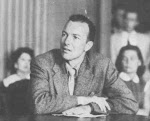This is just a little promo video for this amazing concert video I watched last night. Well, this morning actually. I suppose I should have taken a break in the middle and gone to bed around sunrise but I got caught up. This is Pete at what I think of as a peak for him. He was just beginning to become one of the biggest influences on my life, although almost entirely excluded from American media. He had only recently had his Federal prison sentence for contempt of Congress commuted. I was starting to hear his concerts through Folkways records I found in the basement of the Grandview Library, along with copies of the hard to find Sing Out! magazine in which he had a regular column called Johnny Appleseed, Jr. A new contract with Columbia Records, his first major label since the Weavers got blacklisted in the early ’50s while they were top of the hit parade, resulted in a great Carnegie Hall concert recording from this same year, but I never imagined there would be a way to actually see him performing. At the time he was blacklisted from the TV show named after a phrase he and Woody had made popular. I wonder how it would have affected me at 13 to see him as a human rather than just a disembodied voice and some dramatic still photos. Standing alone in the middle of 3,000 people who sing along reluctantly, and for some apparently cynically, at first; but by the end transformed into an emotional choir. He closed his show, before encores, with a song by “a young friend” of his, Bob Dylan. (Pete was a member of The Old Guard of folk music, 44 years old here.) “A Hard Rain…” Bob’s own record of it had barely been released when Pete did it at Carnegie Hall, and I don’t think it was being heard that much yet. If people knew of Bob at all, it was as a guy who wrote some Peter, Paul and Mary hits, but sounded too funny to actually listen to. It was interesting to see that Pete was still using crib notes on it here. He wasn’t reading it, no music stand nonsense, but you can see him glancing down at his feet between lines to check what came next.
One thing that weirdly stuck out to me, having had my ears ruined by the age of electronic tuners, was that he was never quite in tune through the whole concert. He would take a few seconds to tune, usually not the string that I was noticing was bad, but he didn’t obsess about it. Went from Drop D to standard on the 12-string, kept moving the capo up and down sometimes in the middle of a song when he decided it was not in the best key for everyone to sing, and therefore having to change the 5th string on the banjo. It seemed so obvious to me during the brief attempt at tuning that he hadn’t got it. But, he just charged right on, and once he got going it really didn’t matter a bit.
That studio clip where he is chopping the log was during a long segment on some TV show devoted to a salute to Leadbelly. After he finishes chopping through the work song, he looks up at the camera and says “Well that’s a ridiculous thing to do on TV, isn’t it? It doesn’t belong on a screen! Well, face it, folk music doesn’t belong on a stage, either.” Then he goes on and chops along to a film of Leadbelly doing “Take This Hammer.”
It’s just such a fascinating contradiction how he continually had massive success in industries he considered essentially wrong, and made a virtue of it.


